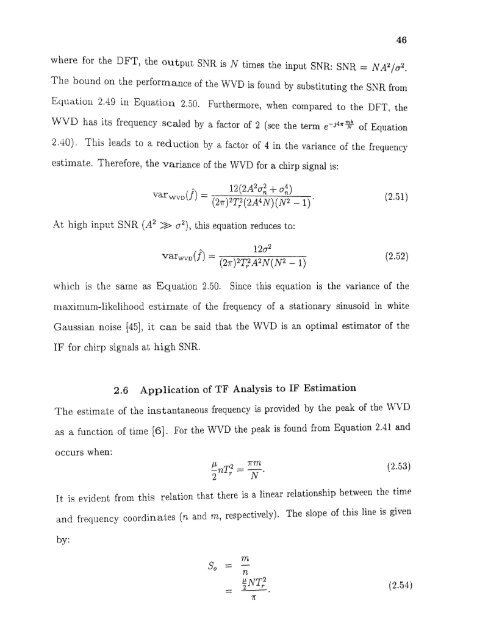Space/time/frequency methods in adaptive radar - New Jersey ...
Space/time/frequency methods in adaptive radar - New Jersey ...
Space/time/frequency methods in adaptive radar - New Jersey ...
You also want an ePaper? Increase the reach of your titles
YUMPU automatically turns print PDFs into web optimized ePapers that Google loves.
46where for the DFT, the output SNR is N <strong>time</strong>s the <strong>in</strong>put SNR:The bound on the performance of the WVD is found by substitut<strong>in</strong>g the SNR fromEquation 2.49 <strong>in</strong> Equation 2.50. Furthermore, when compared to the DFT. theWVD has its <strong>frequency</strong> scaled by a factor of 2 (see the term2.40). This leads to a reduction by a factor of 4 <strong>in</strong> the variance of the <strong>frequency</strong>estimate. Therefore, the variance of the WVD for a chirp signal is:At high <strong>in</strong>put SNR (A 2 a²), this equation reduces to:which is the same as Equation 2.50. S<strong>in</strong>ce this equation is the variance of themaximum-likelihood estimate of the <strong>frequency</strong> of a stationary s<strong>in</strong>usoid <strong>in</strong> whiteGaussian noise [45], it can be said that the WVD is an optimal estimator of theIF for chirp signals at high SNR.2.6 Application of TF Analysis to IF EstimationThe estimate of the <strong>in</strong>stantaneous <strong>frequency</strong> is provided by the peak of the WVDas a function of <strong>time</strong> [6]. For the WVD the peak is found from Equation 2.41 andoccurs when:It is evident from this relation that there is a l<strong>in</strong>ear relationship betweenthe <strong>time</strong>and <strong>frequency</strong> coord<strong>in</strong>ates (n and m, respectively). The slope of this l<strong>in</strong>e is givenby:
















